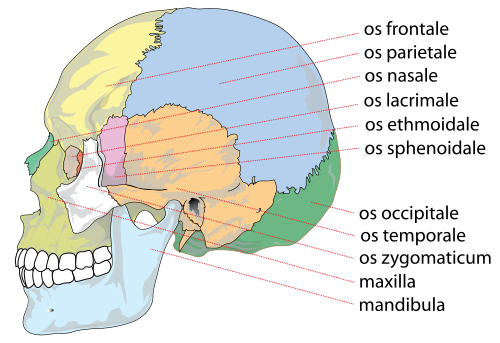Occipital bone

Occipital Bone[edit]
The occipital bone is a vital cranial structure located at the posterior (rear) portion of the skull. It provides structural support and protection for the brain while also offering attachment points for several muscles and ligaments.
Anatomy[edit]
The occipital bone, being flat and roughly trapezoidal, is known for its complexity, housing numerous landmarks and features essential for its functional and structural roles.
Major Features[edit]
- Foramen Magnum: A large aperture located centrally, through which the spinal cord connects with the brain.
- Occipital Condyles: Rounded protrusions on either side of the foramen magnum, enabling articulation with the first cervical vertebra (atlas), facilitating nodding movements of the head.
- External Occipital Protuberance: A prominent midline bump at the lower part of the bone, serving as an attachment for ligaments and muscles.
Development[edit]
The occipital bone originates from multiple parts during embryonic development, but these parts eventually fuse to form a singular bone by adulthood. The fusion process commences during adolescence and typically concludes in early adulthood.
Components[edit]
- Basilar part (or basiocciput): Located anteriorly, forming the region around the foramen magnum.
- Lateral parts (or exoccipitals): Encompassing the sides of the foramen magnum and house the occipital condyles.
- Squamous part: The largest part, forming the back of the occipital bone.
Function[edit]
The primary function of the occipital bone lies in protection. By forming the posterior cranial vault, it ensures the safeguarding of the brain's posterior aspects, including the cerebellum. It also offers insertion points for numerous muscles, thereby facilitating various head and neck movements.
Clinical Significance[edit]
Damage or fractures to the occipital bone can have severe implications due to its proximity to the brain and its association with the spinal cord through the foramen magnum.
- Occipital Neuralgia: A condition resulting from the irritation or injury to the occipital nerves, leading to chronic pain at the base of the skull.
- Occipital Fractures: Typically a result of trauma, these fractures can jeopardize the surrounding neurological structures.
See Also[edit]
|
|
|
| Human regional anatomy | ||||||||||
|---|---|---|---|---|---|---|---|---|---|---|
|
| Neurocranium of the skull | ||||||||||||||||||||||||||||||||
|---|---|---|---|---|---|---|---|---|---|---|---|---|---|---|---|---|---|---|---|---|---|---|---|---|---|---|---|---|---|---|---|---|
|
Ad. Transform your life with W8MD's Budget GLP-1 injections from $75


W8MD offers a medical weight loss program to lose weight in Philadelphia. Our physician-supervised medical weight loss provides:
- Weight loss injections in NYC (generic and brand names):
- Zepbound / Mounjaro, Wegovy / Ozempic, Saxenda
- Most insurances accepted or discounted self-pay rates. We will obtain insurance prior authorizations if needed.
- Generic GLP1 weight loss injections from $75 for the starting dose.
- Also offer prescription weight loss medications including Phentermine, Qsymia, Diethylpropion, Contrave etc.
NYC weight loss doctor appointmentsNYC weight loss doctor appointments
Start your NYC weight loss journey today at our NYC medical weight loss and Philadelphia medical weight loss clinics.
- Call 718-946-5500 to lose weight in NYC or for medical weight loss in Philadelphia 215-676-2334.
- Tags:NYC medical weight loss, Philadelphia lose weight Zepbound NYC, Budget GLP1 weight loss injections, Wegovy Philadelphia, Wegovy NYC, Philadelphia medical weight loss, Brookly weight loss and Wegovy NYC
|
WikiMD's Wellness Encyclopedia |
| Let Food Be Thy Medicine Medicine Thy Food - Hippocrates |
Medical Disclaimer: WikiMD is not a substitute for professional medical advice. The information on WikiMD is provided as an information resource only, may be incorrect, outdated or misleading, and is not to be used or relied on for any diagnostic or treatment purposes. Please consult your health care provider before making any healthcare decisions or for guidance about a specific medical condition. WikiMD expressly disclaims responsibility, and shall have no liability, for any damages, loss, injury, or liability whatsoever suffered as a result of your reliance on the information contained in this site. By visiting this site you agree to the foregoing terms and conditions, which may from time to time be changed or supplemented by WikiMD. If you do not agree to the foregoing terms and conditions, you should not enter or use this site. See full disclaimer.
Credits:Most images are courtesy of Wikimedia commons, and templates, categories Wikipedia, licensed under CC BY SA or similar.
Translate this page: - East Asian
中文,
日本,
한국어,
South Asian
हिन्दी,
தமிழ்,
తెలుగు,
Urdu,
ಕನ್ನಡ,
Southeast Asian
Indonesian,
Vietnamese,
Thai,
မြန်မာဘာသာ,
বাংলা
European
español,
Deutsch,
français,
Greek,
português do Brasil,
polski,
română,
русский,
Nederlands,
norsk,
svenska,
suomi,
Italian
Middle Eastern & African
عربى,
Turkish,
Persian,
Hebrew,
Afrikaans,
isiZulu,
Kiswahili,
Other
Bulgarian,
Hungarian,
Czech,
Swedish,
മലയാളം,
मराठी,
ਪੰਜਾਬੀ,
ગુજરાતી,
Portuguese,
Ukrainian


